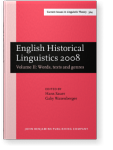The global organization of the English lexicon and its evolution
We present a quantitative study of the semantic network of the set of nouns and verbs of WordNet, which is a systematic representation of the Present-day English lexicon based on psycholinguistic considerations, and A Thesaurus of Old English to understand the evolution of the global organization of the English lexicon. We demonstrate that whereas the semantic network is dominated by the hypernymy tree, which works as the skeleton of the set of nouns and verbs, the inclusion of polysemy produces a drastic global reorganization of the semantic structure, that is, it is converted into a small world, where all meanings are closer to each other. We then show that the words with higher frequency and therefore with higher number of meanings construct the higher level of the hypernymy tree within each lexical category. This architecture is robust through the times, forming the basis of the smallworld network. We also suggest that the small-world topology of the brain has enhanced the small-world configuration of semantic structure.
Cited by (1)
Cited by one other publication
Ogura, Mieko & William S-Y. Wang
This list is based on CrossRef data as of 26 july 2024. Please note that it may not be complete. Sources presented here have been supplied by the respective publishers.
Any errors therein should be reported to them.
